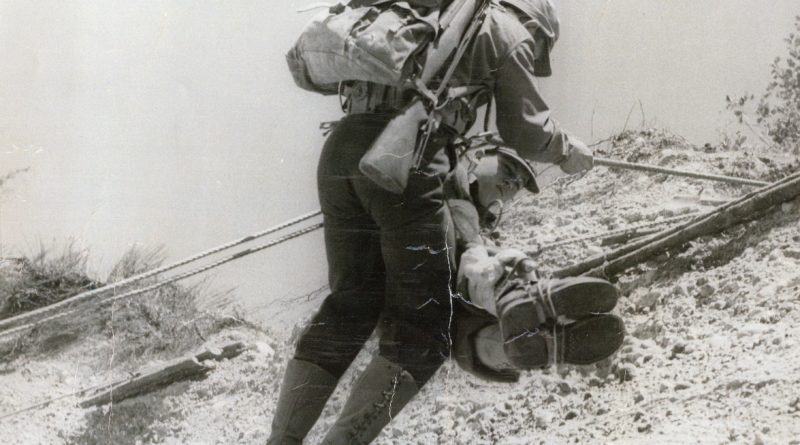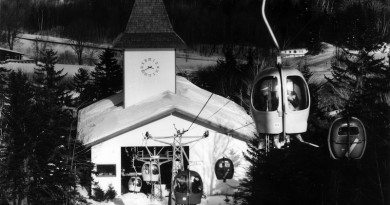The Ski Warriors
How a few Vermont skiers changed the course of history.
BY GREG MORRILL AND MEREDITH SCOTT
In 1944, during one of the last decisive battles of World War II, the 10th Mountain Division was stationed at the base of a steep, 2,000-foot ice-covered cliff north of Florence in Italy’s Appenine Mountains. A battalion of 700 was charged with taking Riva Ridge that winter, a step toward opening the Po Valley, where Italian companies were supplying the Germans with arms. At the top were the Germans and their artillery.
The American troops below were not ordinary soldiers. The U.S. Army’s 10th Mountain Division
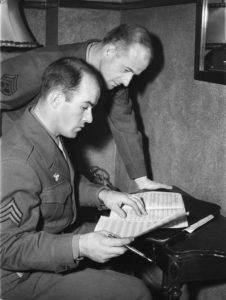
was unique in that it was made up of skiers and mountaineers, including many well-known Vermonters. In the cover of night, protected by fog, they climbed the cliff. From there they successfully took Monte Belvedere, the highest point in the Appenines and were able to descend on the Germans and secure the Po Valley.
During the ensuing battles in the Po Valley, two skiers from Stowe, Austrian-born Werner Von Trapp and his brother Rupert, were on the front lines fighting with the 10th. One night, Werner heard Germans nearby calling orders in the dark. According to his half-brother, Johannes (George and Maria Von Trapp’s son) “Werner used his best Prussian accent to shout out orders in the dark and divert the German patrol from his own.”
“When he came home Werner was quieter, I think he had what we now call PTSD,” Johannes remembers. Together, to give thanks for Werner and Rupert’s safe return, Johannes and his brothers built a stone chapel in the hills behind the family farm. Today, the chapel still stands, just off the trails of the Trapp Family Lodge.
It Started Over Drinks
The Von Trapp brothers were just two of 260 Vermonters who made up the original 10th Mountain Division, the first Army unit to be trained in mountain warfare. The idea of training skiers came about in 1940 after a day of skiing, when Charles “Minnie” Dole, Alex Bright, Roger Langley, and Bob Livermore were enjoying drinks and conversation at Johnny Seesaws pub in Peru, Vt.
One of the topics of conversation that evening was the effectiveness of Finnish ski troops in holding off the much larger forces of the Russian invaders. The Finns eventually succumbed, but not until Russia had to bring in reinforcements from other fronts to secure the invasion.
The United States wasn’t yet a part of the war, but the assembled skiers worried that if England fell, Hitler would have access to Canada and might try to invade the U.S. Their conclusion was that America should develop mountain ski troops.
Minnie Dole had already established the National Ski Patrol, after starting a patrol at Stowe.
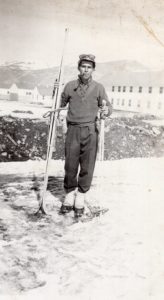
He wrote the United States War Department volunteering the help of the National Ski Patrol in creating and training such a force. Dole’s suggestion fell on receptive ears since the U.S. Army had already begun training forces for winter and mountain combat. They would discover early on that it was going to be easier to train skiers to fight than to train soldiers to ski. Dole became the number one recruiter for skiers to join what would become the 10th Mountain Division and started overhauling gear and helping to train men for winter warfare.
In 1941, 15,000 men applied but only 8,000 were accepted to the 10th. To even join the 10th Mountain Division, early recruits needed three letters of acceptance. Leo Bartlett, had been a volunteer with the Mount Mansfield Ski Patrol before the war and, according to his nephew, historian Brian Lindner, one of Bartlett’s letters of recommendation came from Minnie Dole. Bartlett served with distinction through the end of the war and received a Bronze Star for his action at the Po River crossing.
Vermonters Who Served
Many Vermont members of the 10th Mountain Division were honored for their service with at least four earning the Silver Star, the third highest military decoration for valor. Captain Everett Bailey, a UVM ROTC graduate from Burlington, had been a certified ski instructor at Stowe and was transferred to the 10th when it was formed. As an officer, he looked out for his fellow Vermonters. During training, he discovered that Clem Curtis of Stowe, who had been a ski instructor with Bailey, had been assigned to the snowshoe outfit. Bailey asked Curtis why he was snowshoeing and Curtis’s response was “this is where they put me!” Bailey quickly got Curtis reassigned to his skiing company.
Bailey’s company was part of the battalion that successfully took Torbole from the Germans in the last battle in the European theater of WWII. The commander received a minor injury in that action so Bailey became the acting commander just in time for the German counterattack, according to Bailey’s grandson, Skyler Bailey. As Bailey’s company and battalion were in danger of being cut off by the Germans, Bailey called for more support, then worked his way through the battle to be back with his men as they fended off the counterattack. Bailey received the Silver Star.
Not all who served returned from the war. Overall the number killed-in-action for the 10th Mountain Division was under 1,000, including six Vermonters. Two of those would win the Silver Star for valor. Ev Griffin from Barton was 20 years old and a radio operator. When his squad was pinned down by enemy fire, Griffin moved to an exposed position for better radio transmission to call in artillery. Herbert “Allen” Spaulding of Cavendish was a 30-year-old father of four. For 20 minutes he held off the enemy alone to cover the flanking movement of the rest of his company, which resulted in the capture of the enemy’s position.
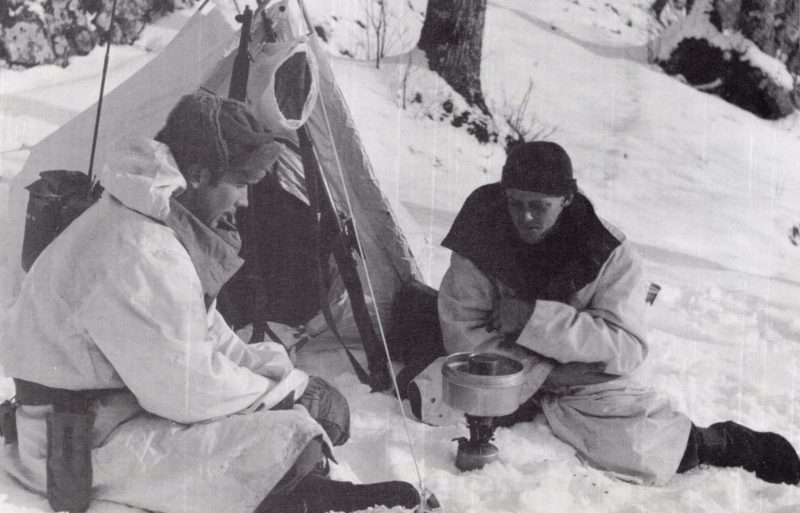
Many of those who did return went on to play key roles in skiing. Clif Taylor fought in the battles at Riva Ridge and Mt. Belvedere. He is best known for his short skis and introducing of the Graduated Length Method (GLM) for teaching skiing. John “Jack” Murphy was one of the founders of the Sugarbush ski area and of the National Ski Areas Association. Bob Ely returned from the war to help launch Mount Ascutney as a lift-served ski area, and under his leadership it became the first area to install snowmaking in Vermont.
Historian Brian Lindner, whose father and uncles served in the 10th, helped pull together much of the information available on the Vermont veterans. Brian’s father Erwin went through rigorous training at Camp Hale in Colorado but was medically discharged before the division went overseas. Erwin returned to Vermont where he became the first full-time, paid patroller on the Mount Mansfield Ski Patrol.
Joe Jones of Mendon had been the Vermont State Alpine Champion in 1942 before joining the 10th. After the war he became the Middlebury College ski coach and went on to found the Vermont Alpine Racing Association (VARA). Another 10th Mountain veteran Leslie Hurley came to Norwich University in 1947 and founded the Mountain and Cold Weather Company, the first ROTC program in mountain and winter warfare in the country. That program still serves in the development of mountain troops today.
Mountain Warfare Today
Today, the 10th Mountain Division is one of the most deployed units in the Army. Since 2001, the 10th Mountain Division (Light Infantry’s) combat brigade have seen over 20 deployments to both Iraq and Afghanistan. And though the Division is headquartered in Fort Drum New York, about 20,000 troops train at the Mountain Warfare School at the Camp Ethan Allen Training Site in Jericho, Vt., each year. They often use Smuggler’s Notch as a training ground for climbing, skiing and avalanche safety and the Jericho facility has one of only three internationally licensed biathlon courses in the country.
Greg Morrill is the chairman of the board of the Vermont Ski and Snowboard Museum. Meredith Scott is the museum’s curator. This winter, the Vermont Ski and Snowboard Museum introduces a new exhibit, “Peak to Peak: 10th Mountain Division Then and Now,” see vtssm.org for information.
Featured Photo Caption: A 10th Mountain Division soldier rappells. Photo courtesy the Vermont Ski and Snowboard Museum.

